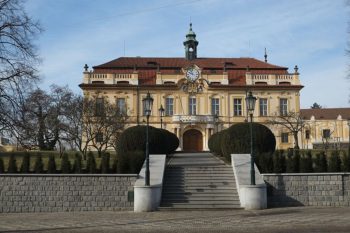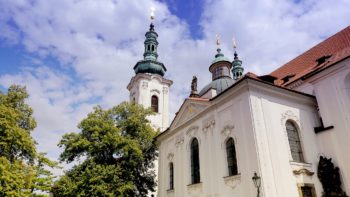Stage 8. Praha Prosek – St. James´s Church in Zbraslav
From: St. Wenceslaus Church in Prosek (metro Prosek)
To: St. James´s Church in Zbraslav
Length: 34 km
Route Description
This stage starts in Prosek next to the St. Wenceslaus church where you can get on Zittau way through Kbely and then Mladoboleslavská and Čakovická Street. In this street you can see the first and most beautiful chapel of Via Sancta from Prague to Stará Boleslav. Take Prosecká Street and you will shortly reach the church of St. Wencelaus in Prosek.
The old village of Prosek existed already in 12 century and from that time also comes the church of St. Wenceslaus. There were vineyards in here in those days, which are now being restored. You will pass the vineyard pole towards Prosecká Street, cross it, continue down through the park and pass the former vineyard houses such as Jetelka and Kelerka, pass the little pond which used to be important for the village and continue towards railway station Vysočany.
In front of the railway station, take the tunnel below the rails and turn right into park Podvinní.
The park has got a very nice relaxation zone. Follow the Rokytka Creek, which cuts through the park.
By Kolčavka house where the park ends, undergo the motorway to get to the cycleway. Follow the stream of Rokytka all the way to Libeň. You can see here a little chapel which was saved by the locals from a demolition. Village Libeň is a very old settlement. It is mentioned in annals for the first time in 1363. From the chapel cross Zenklova Street where there is a beautiful building of Sokolovna and also wooden church of St. Wenceslaus which was originally build as a temporary building.

Go back around Sokolovna towards Libeň chateau which was built in 3 mains phases – Renaissance, Baroque and Rococo. Walk around the chateau and continue to follow the streem of Rokytka and alongside the old mill towards Vltava River. Leave behind Libeň, which, apart from other things, used to be a winemaking setting. The old names such as Na Balabence, Palmovka, Pelc-Tyrolka, Truhlářka, Rokoska etc. remind of the past. Libeň also had a numerous Jewish community. This part of Prague was flourishing in 19 century when there was a big industrial development.
After influx of Rokytka and Vltava River continue on the river bank all the way to Troja.
On the way you can notice the water cannal as well as the Troja chateau which was built during the early Baroque era by J. K Mathey as a summer house for Count V. Vojtěch of Šternberg.
Cross the river through the Troja Island down to Stromovka. This game park was funded by Jan Lucemburský. On the top of the hill, there is a former governor´s summer palace which was funded by Wladyslav Jagiello as a hunter´s lodge.
Go through Stromovka to Letná, the best way is to take Čechova Street, cut through Milada Horáková Street and carry on taking Nad Štolou to Letenská pláň (plain). Pass the National Technical Museum and National Museum of Agriculture and enjoy the view of Prague by the Letenský chateau.
Cross the Vltava River taking Štefánikův Bridge to the cloister Na Františku.
The former cloister of St. Agnes is one of the most precious monuments in Prague. It was funded by the king Wenceslaus I. before 1234 for the Order of St. Clare. The project was initiated by king´s sister Agnes. At the same time there was a monastery funded next to it to accommodate the Franciscan order.
Continue through Řásnovka, pass Halštatské Square, Rybná and Jakubská Streets to the church of St. James.

The church and former monastery of St. James was also funded by Wenceslaus I. in 1232. The temple has a decorative frontispiece and was redecorated in Baroque style between 1689 and 1702. There is a building of former Franciscan monastery next to it where there are still some medieval features. In summer refectory, a wedding feast of the king Jan Lucemburský with Beatrice took place in 1337.
Opposite of the church there is an entrance to Ungelt, a court form 11th century, which served to protect the foreign merchants and their goods. It developed into a customs office later on.
The original name of this court was Týn. Attached to it is a church of Our Lady which also contained a hospital for the foreign merchants. This church was rebuilt in the second half of 13th century and was finished just before Hussite wars. It caught fire later on and was rebuilt again. It was the main city church during the Hussite era.
You can have a look around the Old Town Square and its many historical buildings, especially the Old Town Hall with its Astronomical Clock.
Then continue to Malé (Little) Square through Karlova Street to Karlův (Charles) Bridge. Crossing the bridge you will enter Malá Strana (Lesser Quarter). Take Mostecká Street to Malostranské Square.
The dominant building here is the church of St. Nicolaus which was built in 1704-11 by Kryštof Dienzenhofer in place of an old medieval church.
Take picturesque Nerudova Street to climb up the hill towards the Prague Castle, the residence of Czech Princes, Kings and nowadays presidents. It has always been a symbol of the Czech state. There were four important church buildings there already in 10th century. The cathedral of St. Vitus stated to be built by Charles IV. as a part of a massive renovation of the Prague Castle
into a representative residence.
Cut through Hradčanské Square and take Loretánská Street to Loretánské Square, which was built during the renovation of Czernin Palace in 1669. This building is now a home to the Czech Ministry of Foreign Affairs.
Opposite of MFA you can find Loreta which contains glockenspiel and Santa Casa in its walls. It is a pilgrimage site. At the lower end of the square you can find a Capuchin monastery which offers accommodation to pilgrims.

From there continue to Strahov monastery which belongs to the Premonstratensian Order. It was funded in 1140 by Vladislav I. It went through many reconstructions to get today look. However, the Abbot Temple of Our Lady is originally a Romanesque Basilica. The monastery is a vast building and is worth visiting, especially its beautiful library, the biggest in the Czech Lands.
Outside, leaving the monastery behind your back, you can enjoy a magnificent view of Prague. Then take the route on your right and continue to Petřín Mountain.
On the way enjoy the view of the palaces below you until you reach a restaurant (careful, it is not Nebozízek, which is a bit further down), turn down the hill in Seminářská Garden to Helichova Street. In Karmelitská Street, turn left towards the church of Our Lady Victorious. From 1628, they keep the statue of the Prague Infant Jesus there, which is a work of Spanish Renaissance,
a gift from Polyxena of Lobkowitz.
Go to Harantova Street through Maltézské Square to Kampa, cross Čertovka Creek and turn right. Cross Vltava River on the Legion Bridge (most Legií) towards National Theatre.
Following the Vltava River stream you will come to leave the city. Passing Vyšehrad you will leave the city centre. Still walking on the river bank you will reach Zbraslav where you will join the tourist marking enhanced by the St. James´s shell marking. This is where the path changes to Všeruby or Železná way.
